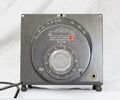1215-C: Difference between revisions
Jump to navigation
Jump to search
No edit summary |
No edit summary |
||
| Line 19: | Line 19: | ||
Direct amplitude modulation at audio frequencies is provided by a front panel phone jack. | Direct amplitude modulation at audio frequencies is provided by a front panel phone jack. | ||
With | With a [[1000-P6|1000-P6 Crystal Diode Modulator]] accessory, frequencies from 0 to 5 MHz can be used to provide amplitude modulation. | ||
As a unit oscillator, the 1215-C requires an external power supply, type [[1203-B]] is recommended. | As a unit oscillator, the 1215-C requires an external power supply, type [[1203-B]] is recommended. | ||
Latest revision as of 20:07, 28 May 2024
The General Radio 1215-C Unit Oscillator was introduced in Catalog R (1963) and remained available through Catalog 1973.
The Type 1208-C is a general-purpose frequency source covering 50 to 250 MHz. It finds use as a generator for bridges, admittance meters, and impedance meters.
Direct amplitude modulation at audio frequencies is provided by a front panel phone jack. With a 1000-P6 Crystal Diode Modulator accessory, frequencies from 0 to 5 MHz can be used to provide amplitude modulation.
As a unit oscillator, the 1215-C requires an external power supply, type 1203-B is recommended.
Specifications
- Frequency Range: 50 to 250 MHz
- Calibration Accuracy: ±1%
- Warmup Frequency Drift: 0.4% typical
- Output: 100 mW into 50 Ω with Type 1269-A power supply
Links
- Experimenter August 1963 describing Unit Oscillators
- Patent for the Butterfly Tuning Circuit
- Compatible with 908-P1 Synchronous Dial Drive and 908-R96 Synchronous Dial Drive
Photos
-
-
-
-
-
-
-
12AT7 Oscillator Tube







